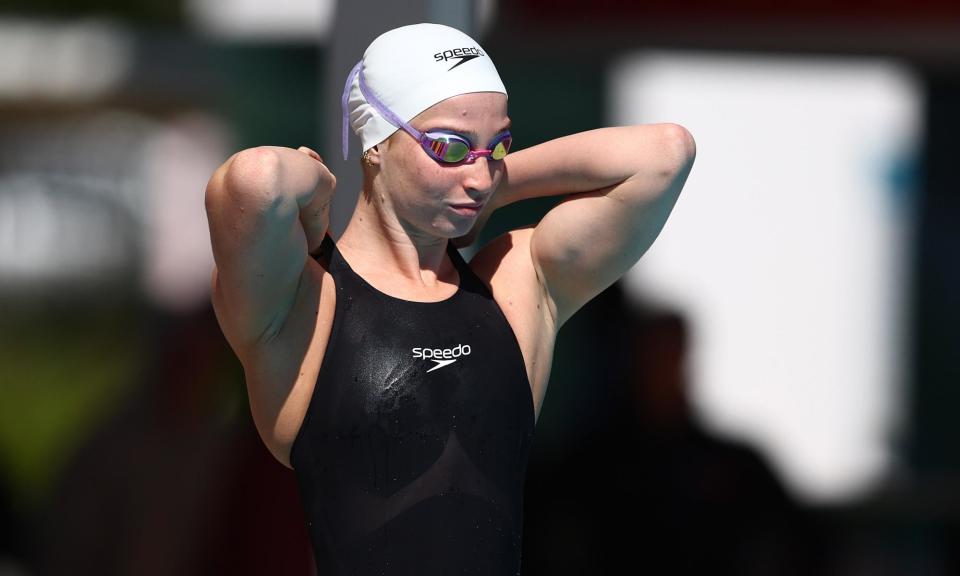Mollie O’Callaghan: Australia’s ‘dolphin in a human body’ set for bumper Olympic haul

There’s something about Mollie O’Callaghan, and everyone inside Australian swimming knows it. The world 100m and 200m freestyle champion is shaping as one of the most important athletes for Australia at this year’s Olympic Games – one who could return with at least a fistful of medals.
O’Callaghan has just turned 20 but is on track to becoming an international star. At last year’s world championships in Fukuoka, she claimed both the 100m and 200m freestyle titles, defeating Olympic champion Ariarne Titmus in the latter. She also took down one of the most revered world records in the sport, the 14-year-old 200m monument established by Italy’s Federica Pellegrini.
And there is every sign that O’Callaghan is a better swimmer now than she was then, as demonstrated by her startling victory over her clubmate Titmus in the 200m freestyle final at the Australian championships on Saturday night.
While still in work as she prepares for the Olympic trials in June, O’Callaghan put together a sensational performance, stopping the clock in 1:53.57, the only sub-1:54 mark in the world this year, and little more than half a second outside her own world record of 1:52.85. She also left the immensely-competitive Titmus more than a body-length behind.
Afterwards, O’Callaghan said: “I think that’s probably where I should be, although I would like to go faster – I always do.”
In all likelihood, O’Callaghan is just getting started. She’s coming to a peak at just the right time for Paris, and Australia’s best judges of swimming can only admire her abilities.
Michael Bohl has coached two of Australia’s most successful Olympic swimmers in history – multiple gold medallists Emma McKeon and Stephanie Rice – and he’s excited by what he sees in O’Callaghan, coached by his former assistant Dean Boxall.
“She puts her race together beautifully,” he said. “She’s textbook, the way she swims. She’s a great athlete, she’s technically great, she’s got all the great [underwater] skills, she structures her race well, she’s got good balance, she’s got a good front end [to her race] and a super back end. She just covers a lot of the bases.’’
That’s why Bohl is telling 29-year-old McKeon, a five-times Olympic gold medallist, that she may need to be better than her best to defend her Olympic 100m freestyle title in Paris against the likes of the younger O’Callaghan.
What sets O’Callaghan apart, according to those who have studied her most closely, is her kicking and her competitiveness.
In the 50m backstroke final at the national titles last week, triple Olympic champion Kaylee McKeown (also coached by Bohl) needed everything she had to overcome O’Callaghan in what was, for her, a bit of fun.
World record-holder McKeown admitted afterwards that she was wary of O’Callaghan. “Her underwaters are phenomenal, better than mine, so I won’t discount her by any means,” she said. “Freestyle, backstroke, she’s good.’’
O’Callaghan has yet to decide if she will try to qualify for the 100m backstroke at the Olympic trials, given her likely Paris program already includes six events – the 100m and 200m freestyle and four relays.
But she handled that schedule masterfully at the world titles in Fukuoka, emerging with five gold medals, one silver and three world records. So there will be temptation to add the 100m backstroke, after she won the national title (in McKeown’s absence) in a personal best of 58.09, which lifts her into the top three in the world this year.
According to her childhood coach Paul Sansby, at the Waterworx club west of Brisbane, O’Callaghan had many of those champion traits from the start, when the little red-haired girl walked into his pool as a seven-year-old.
“She was willing to do the work, she had a good range of movement, good flexibility,” he said. “She’s pigeon-toed so she’s not made to walk on land.”
O’Callaghan had always used her hyper-extension in the knees to great effect in kicking through the water. “She’s what they call ‘slippery in the water’,” Sansby said. “She could go four or five metres further under water than anyone else with the same effort.
“She’s not the biggest, she’s not the strongest, but she’s super-efficient in the water. She’s waterborn. She’s a dolphin in a human body. Underwater, it’s like her whole body does what it has to do with fluid motion.”
O’Callaghan also has one of the most prized assets in an elite swimmer, and that is easy speed. She can relax in the water while travelling at peak speed. She doesn’t tighten up her body under pressure or fatigue, which gives her that trademark finishing power. She maintains her speed while others are losing theirs.
The one thing O’Callaghan doesn’t have on her side is height. At 175cm, she’s shorter than most of the leading sprinters, but Sansby says being smaller than her rivals as a child was one of the reasons she became such a fighter.
“One of the main things about her is that she’s fiercely competitive, she’s a killer,” he said.
O’Callaghan got a taste of Olympic competition when she was selected as a relay alternate, aged 17, for the Tokyo Olympics in 2021. She thrived in that environment, leading off the 4x100m and 4x200m freestyle relay teams in personal best times, but she was not selected to swim in the finals.
That merely left her hungry for more. A year later she was the world 100m freestyle champion, and three years further on, she’s the one that everyone is watching.

 Yahoo Sport
Yahoo Sport 



































































